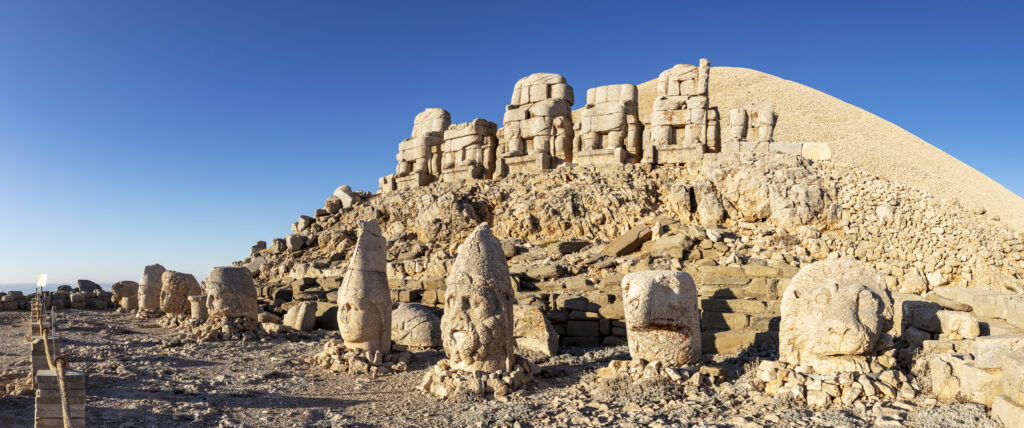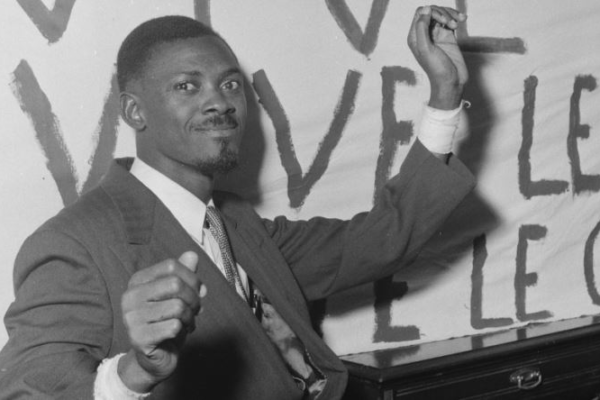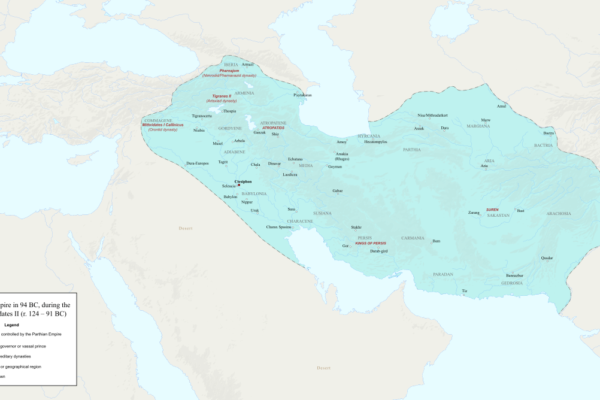Mount Nemrut - Where Earth Touches Eternity
High atop the rugged spine of the Eastern Taurus Mountains in southeastern Anatolia, there rises a summit unlike any other. Mount Nemrut, standing at a commanding elevation of 2,134 meters above sea level, is not merely a mountain , it is a gateway between the heavens and the earth, a timeless throne where kings sit beside gods, and where silence speaks of forgotten empires.
Up there, in the thin air and vast stillness, the colossal stone deities of Nemrut gaze eternally into the cosmos, their eyes hollowed by time yet filled with celestial purpose. As the stars wheel overhead in eternal procession, these silent titans witness the passage of millennia with the stoicism only stone can know. Day breaks upon their foreheads; night cloaks them in myth. The sky is their shroud, and the mountain their temple.
This is not merely a scenic height , it is a monument to divine kingship, a sacred sanctuary, and an imperial tomb built by human hands yet carved with the ambition of immortality. In the 1st century BCE, a king named Antiochus I Theos of Commagene, born of Persian and Macedonian blood, ordered the construction of this mystical site. His vision was not to merely be remembered, but to ascend to exist beyond the confines of mortality, as one who communed with gods, and in doing so, became one.
“Let my deeds not perish in silence, but live on among those not yet born.”
— Antiochus I Theos Tweet
The Kingdom of Commagene: Born Between Worlds
To fully grasp the significance of Mount Nemrut, one must first understand the unique legacy of the Kingdom of Commagene. Nestled between the mighty Euphrates River and the towering peaks of the Taurus Mountains, this small yet remarkably sophisticated state thrived during a time of great political upheaval.
Following the fragmentation of the once-mighty Seleucid Empire, Commagene emerged as a regional power. Its strategic location placed it directly between two great spheres of influence: the Hellenistic West and the Iranian East. As a result, Commagene did not simply absorb these cultures — it actively blended them, forging a hybrid identity that was both distinctive and inclusive.
Crucially, the rulers of Commagene understood the power of heritage. King Antiochus I Theos, the dynasty’s most ambitious and visionary monarch, traced his ancestry back to Alexander the Great on his mother’s side and to the Achaemenid Persian kings on his father’s. This dual lineage was not merely a matter of pride. For Antiochus, it was a divine mandate , a sacred calling to bridge two worlds.
He did not see himself as just a sovereign ruling over a borderland. Instead, he envisioned himself as a mediator between gods and mortals, a chosen figure who stood at the crossroads of history and myth. This vision culminated in the construction of Mount Nemrut, a monumental declaration carved into the bones of the earth.
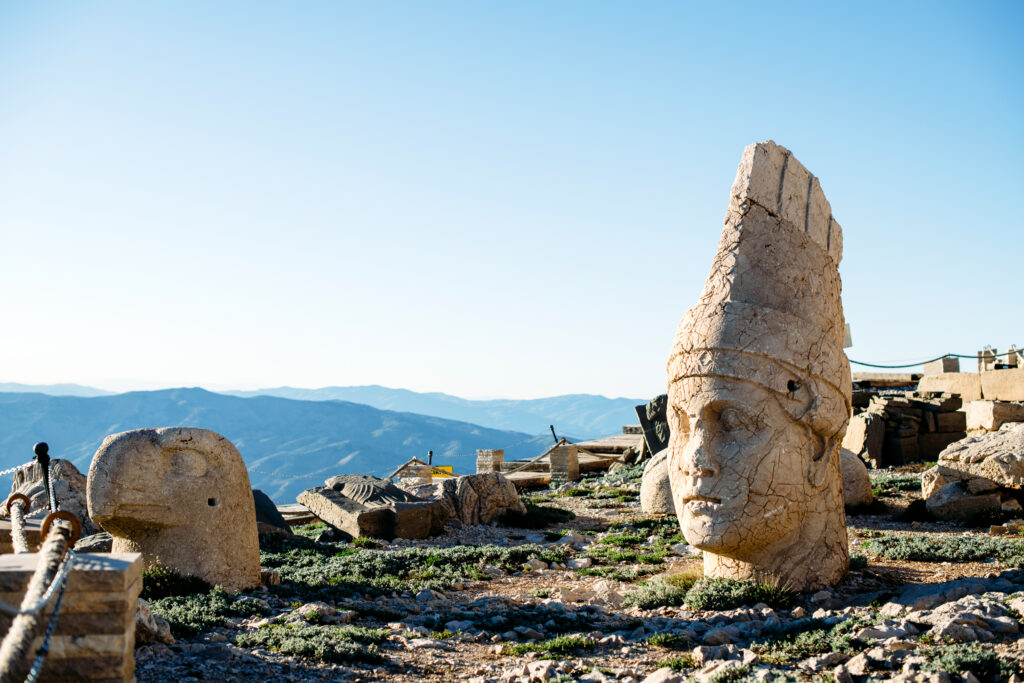
The Sanctuary at the Summit, Architecture of the Divine
At the summit of Mount Nemrut, King Antiochus ordered the construction of a grand tumulus — a man-made mountain of crushed stone covering his royal tomb. Around it, on the East and West terraces, stood massive colossal statues , each over 8 meters tall representing a pantheon of gods and kings:
-
Zeus–Oromasdes: A fusion of the Greek Zeus and Persian Ahura Mazda.
-
Apollo–Mithras–Helios–Hermes: The sun god in various forms.
-
Heracles–Artagnes–Ares: A hero-god blend of East and West.
-
King Antiochus I himself, depicted as divine.
-
Tyche: The goddess of fortune.
These statues were seated on thrones, lined with eagle and lion guardians, and flanked by reliefs of Antiochus shaking hands with the gods a bold claim to divinity. Behind them, inscriptions in Greek detail Antiochus’s vision: a sacred law (nomos) meant to endure forever.
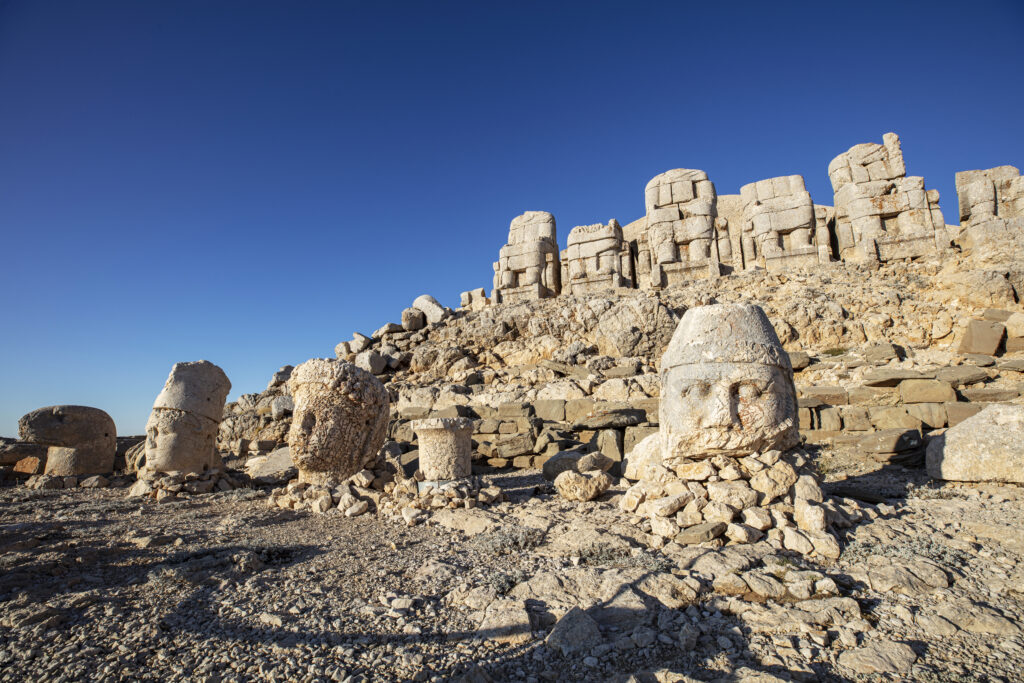
The Tumulus - Mount Nemrut
At the very heart of Mount Nemrut lies its most enigmatic feature , the tumulus. This towering, man-made mound rises approximately 50 meters high and stretches over 150 meters in diameter. It is composed entirely of small, loose, angular stones, deliberately piled to form a conical hill. On first glance, it may seem like a simple heap of rocks. However, upon closer reflection, it reveals a deeper, more symbolic function.
Unlike traditional tombs carved into rock or built from solid blocks, this tumulus was designed to conceal and protect. Its loose composition not only resists erosion but also makes excavation nearly impossible, even with modern technology. This was no accident. Rather, it was an intentional act a way of ensuring that what lay beneath would remain untouched by time, looters, or empires to come.
Over the years, numerous archaeological surveys, including radar scans and core drilling, have been conducted in hopes of locating the actual tomb of King Antiochus I. Yet, despite persistent efforts, no burial chamber has ever been found. This absence has only added to the mountain’s allure, cloaking it in layers of mystery, speculation, and legend.
Some scholars argue that the tomb rests directly beneath the tumulus, hidden deep within the central core. Others propose the existence of hidden passages or subterranean chambers tucked beneath the surrounding terraces. While theories abound, none have been definitively proven. As a result, the true resting place of Antiochus remains unknown a deliberate enigma set in stone.
Nevertheless, and perhaps most importantly, the king’s desire for eternal remembrance has already been fulfilled. Whether or not his body lies beneath the mound, his legacy lives on. Mount Nemrut itself has become his monument, a timeless structure that continues to defy erosion, escape certainty, and resist oblivion. Through this silent, enduring tomb, Antiochus’s ambition to join the divine and transcend mortality remains firmly etched into the memory of the world.

East and West Terraces
To truly appreciate the spiritual and architectural genius of Mount Nemrut, one must explore its monumental terraces. These platforms arranged with mathematical precision — serve as ceremonial spaces, aligning earth with the rhythms of the sky.
The East Terrace stands out as the most visually striking and best-preserved section of the site. Here, colossal stone thrones line the platform, behind which once stood towering statues of gods and kings. Today, the heads of these statues, toppled by centuries of earthquakes or possibly religious iconoclasm, now rest solemnly in front of their seated bodies. This eerie arrangement, though the result of destruction, adds a profound sense of reverence to the landscape.
As the first light of dawn touches the mountain, the eastern statues are bathed in a golden glow. This daily event is not just aesthetically beautiful; it carries symbolic weight. Many scholars interpret this orientation as intentional, possibly reflecting sun worship, solar rituals, or celestial alignments tied to the king’s divine vision. The rising sun, associated with life and rebirth, may have marked sacred times for offerings or royal remembrance.
On the opposite side, the West Terrace mirrors much of the same layout. However, upon closer inspection, one notices subtle variations in style, size, and arrangement. This terrace receives the setting sun, casting long shadows over the stone figures. The transition from light to darkness here is deeply symbolic. According to some interpretations, the East and West terraces represent a duality life and death, sunrise and sunset, or beginning and end. Together, they may symbolize the eternal cycle that King Antiochus envisioned: one in which he would eternally exist between heaven and earth, light and shadow.
In addition to these primary platforms, there is also a North Terrace. Though far less grand in scale, it is thought to have served a ceremonial or processional purpose. It may have functioned as a transitional path between the two larger terraces, reinforcing the spatial narrative of movement between opposites between birth and death, between man and god.
Altogether, the terraces at Mount Nemrut are not merely platforms of stone. They are expressions of sacred geometry, tied to astronomical cycles and philosophical ideas. Through them, Antiochus I created a stage upon which time itself was ritualized, and his memory forever etched in the shifting light of the Anatolian sun.
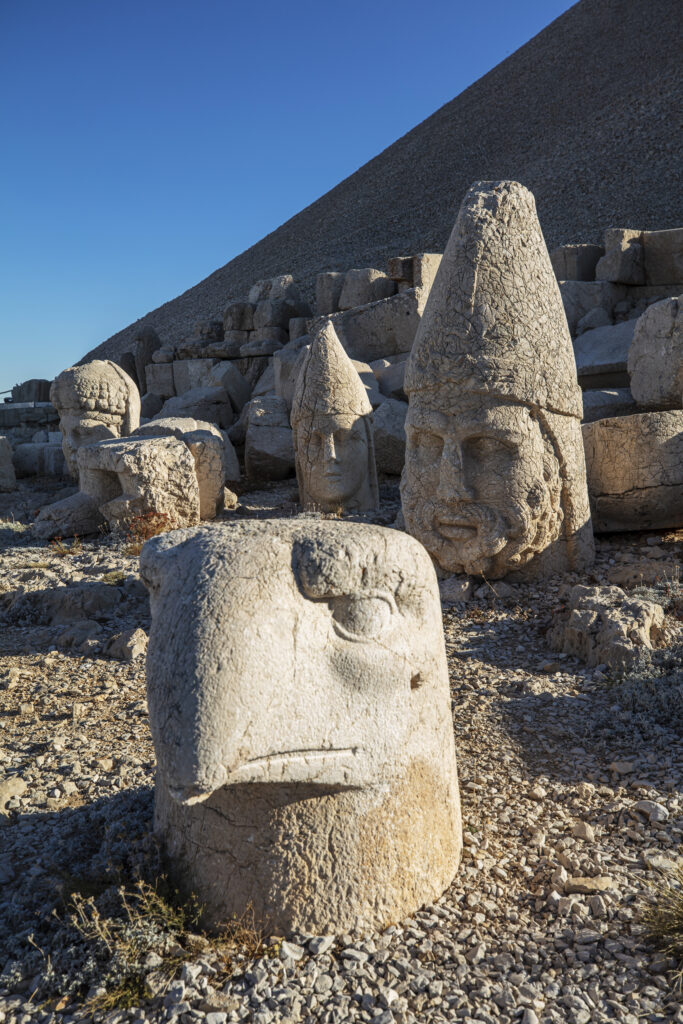
Hellenism Meets Zoroastrianism
One of the most remarkable aspects of Mount Nemrut is its extraordinary cultural fusion. At first glance, the statues and artistic motifs reflect the influence of Hellenistic art with idealized human forms, symmetrical compositions, and classical Greek expressions of divinity. However, as one looks deeper, the underlying spiritual themes reveal a different origin.
In fact, many of the beliefs and symbols embedded within the site draw heavily from Zoroastrianism, the ancient Persian religion that emphasized the cosmic struggle between light and darkness, order and chaos. This synthesis is not accidental. Rather, it reflects the deliberate vision of King Antiochus I, who sought to unify his diverse subjects through a shared and symbolic mythology.
While the gods appear Greek in form, their names and meanings often carry Persian attributes. For example, Zeus is merged with Oromasdes (Ahura Mazda), and Apollo is linked with Mithras and Helios. Through these hybrid identities, Antiochus crafted a pantheon that could resonate with both his Greek-speaking elites and his Iranian-rooted nobility.
Moreover, the structure of Mount Nemrut itself recalls elements found in Anatolian religious sites, particularly in its use of elevated platforms, monumental symbolism, and alignment with celestial phenomena. In this way, Antiochus did not favor one tradition over another. Instead, he created a sacred space where multiple worldviews could coexist.
Even the lengthy Greek inscriptions at the site reinforce this fusion. Though written in Greek, their content reflects Zoroastrian principles. They speak of truth, justice, fire, and the stars — all central elements in Zoroastrian cosmic order. This shows that Antiochus’s message was not confined to the visual realm; it extended into the spiritual and philosophical language of his time.
Taken together, these elements transform Mount Nemrut from a simple funerary monument into something far greater. It becomes a cosmopolis in stone a sacred and symbolic capital that brings together the mythologies of East and West, the art of the Greeks, the faith of the Persians, and the spirit of Anatolia. Through this intricate blend, Antiochus I secured not just political unity, but also a lasting cultural legacy that still speaks across time.
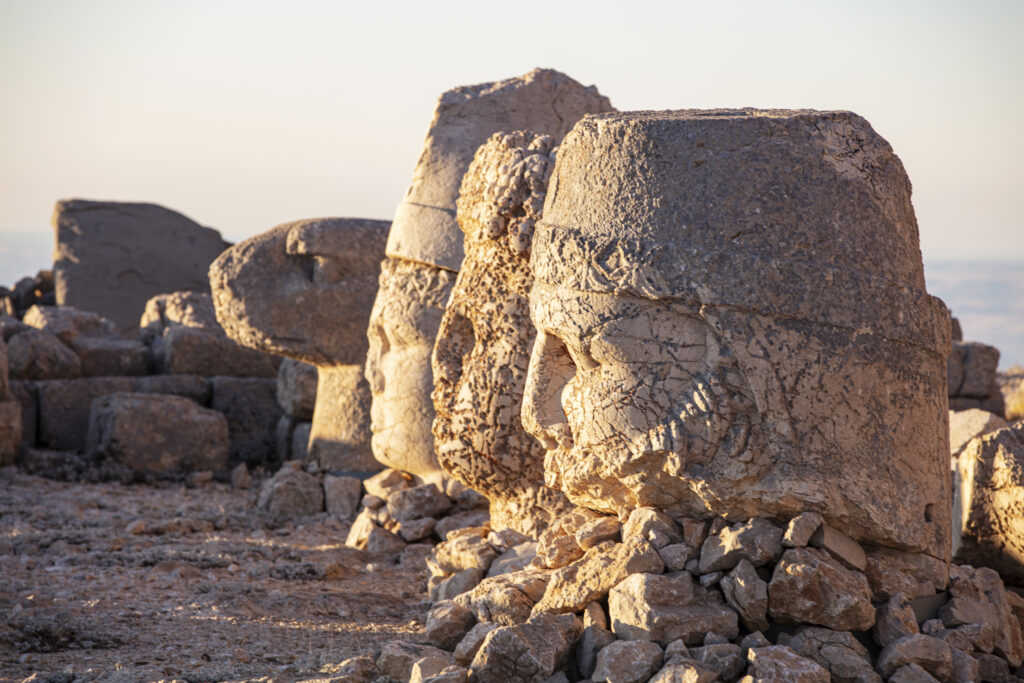
Rediscovery and Modern Significance
For centuries, Mount Nemrut remained a silent sentinel isolated, windswept, and forgotten by history. Although local communities knew of its existence, the true importance of the site had faded into obscurity. It wasn’t until 1881 that its story began to reemerge. That year, Karl Sester, a German engineer working in the Ottoman Empire, came across the colossal stone heads while surveying the region for road construction.
His discovery marked the beginning of modern interest in the site. As archaeologists, historians, and explorers arrived in the years that followed, the significance of Mount Nemrut became increasingly clear. It was not simply a collection of ancient ruins it was a cultural and spiritual time capsule. Gradually, the mountain gained recognition as one of the most enigmatic archaeological wonders of the ancient world.
Thanks to its extraordinary historical and artistic value, UNESCO designated Mount Nemrut a World Heritage Site in 1987. This acknowledgment helped preserve the site and brought international attention to its delicate and mysterious beauty.
Today, the mountain draws thousands of visitors from around the globe. Most arrive before sunrise, making the climb in silence and anticipation. As the first light of day spills over the peaks, it illuminates the fallen heads of gods, casting long shadows across the stone. In that moment, the line between myth and memory seems to disappear. The air grows still, and time feels suspended. It is an experience that moves many not just visually, but spiritually.
Meanwhile, archaeological excavations at Mount Nemrut continue. New fragments, architectural insights, and traces of ritual activity are still being uncovered. Yet, despite modern technology and decades of research, the tomb of Antiochus I remains elusive. The mountain seems to guard its greatest secret with purpose as if honoring the wishes of a king who sought not only remembrance, but divine transformation.
In this way, Mount Nemrut lives on. Not as a ruin of the past, but as a living monument one that still inspires awe, curiosity, and reverence. It reminds us that ambition carved in stone can survive centuries, and that somewhere, above the clouds, a king may still be dreaming in silence.
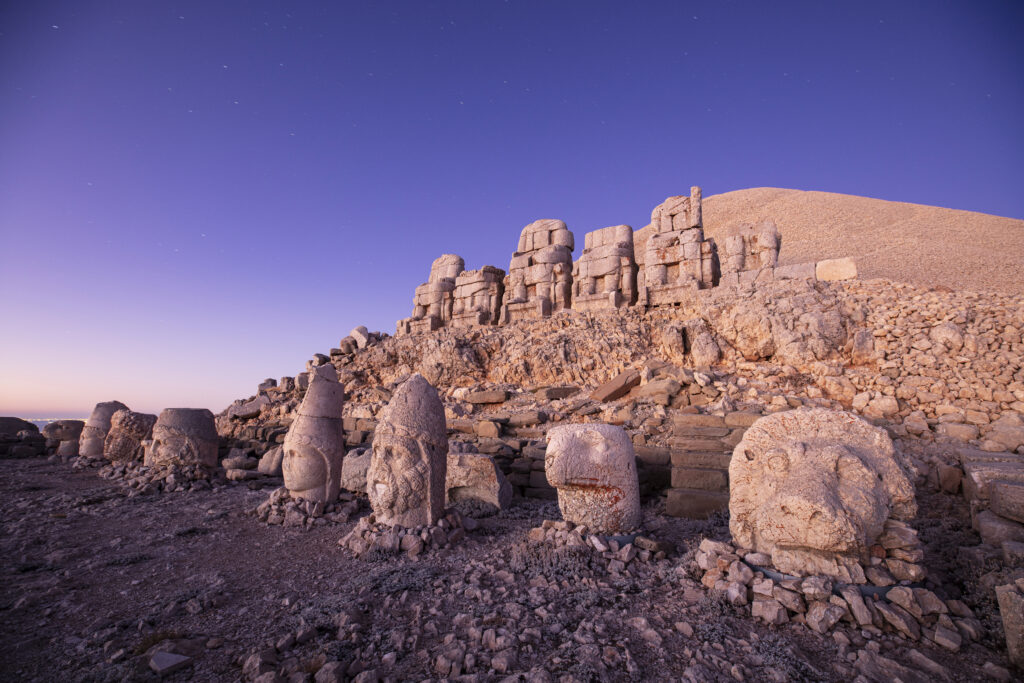


![Coin of Arsaces I. The reverse shows a seated archer carrying a bow, with the Greek legend reading "ΑΡΣΑΚΟΥ" (right) and "[AYT]OKPATOP[OΣ]" (left), meaning [coin of] "Arsaces"](https://historifyproduction.com/wp-content/uploads/2025/04/500px-Coin_of_Arsaces_I_1_Nisa-1-150x150.png)

